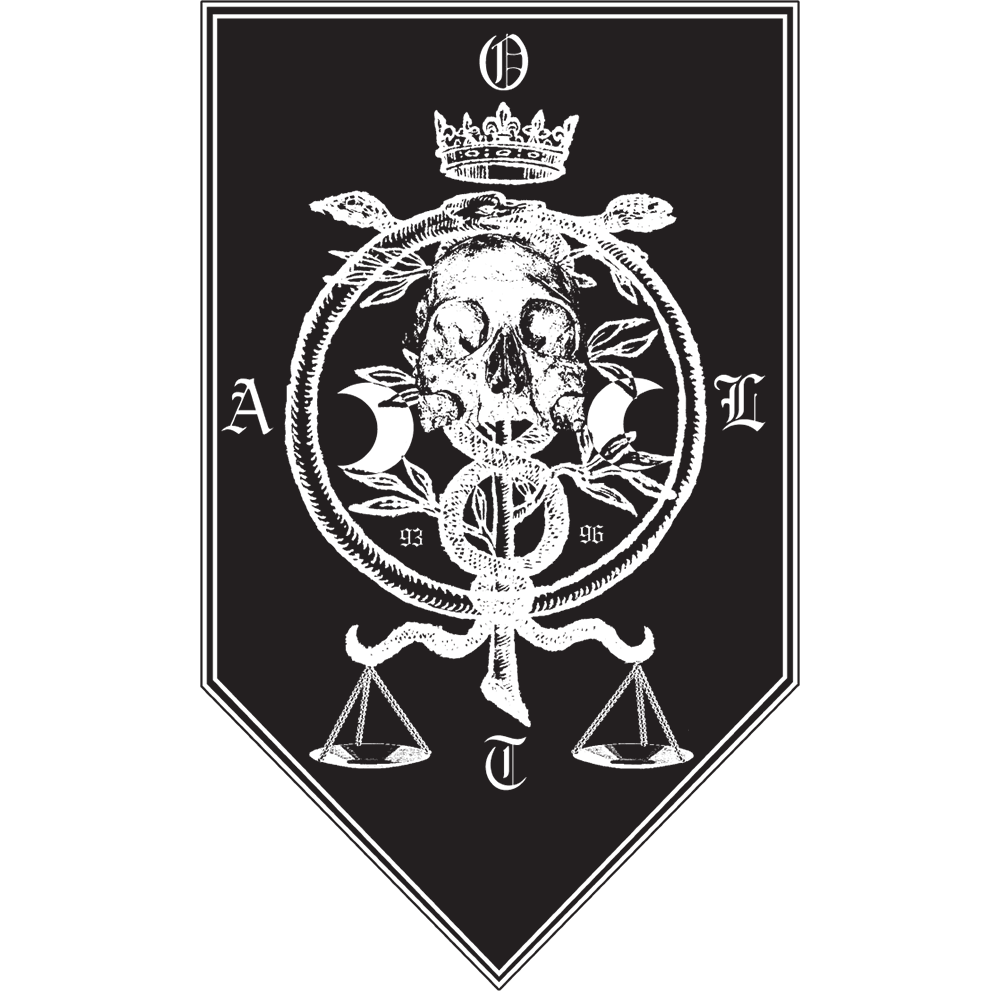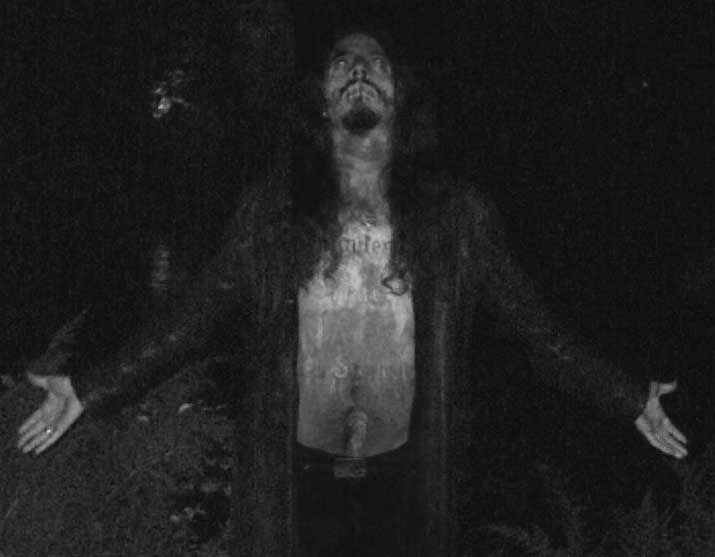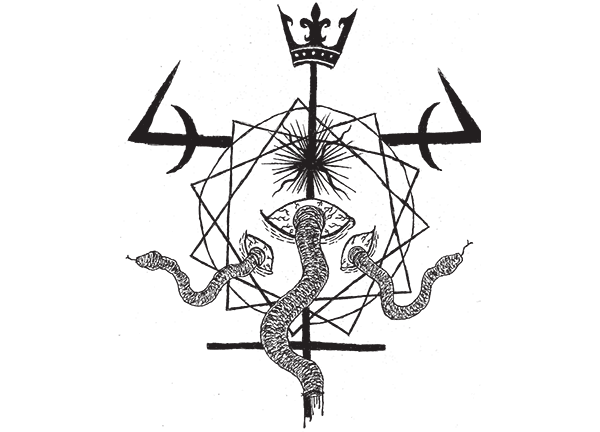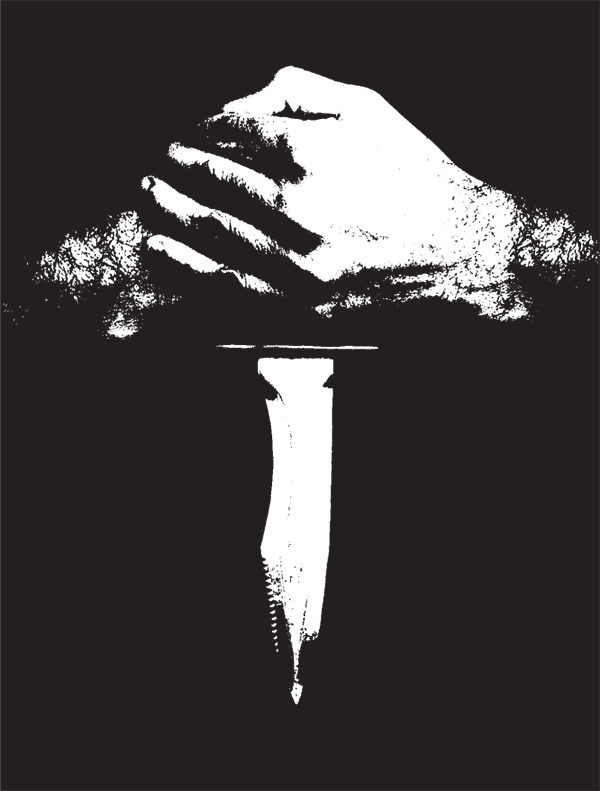Ordo Templi Aeternae Lucis
2021-02-24
by Niklas Göransson
Bluish flesh for me to hold, waiting in a temple of meat and bone – a conversation on the union between life and death with Hunferd of French black metal band Ordo Templi Aeternae Lucis.
The following is an excerpt from the full article, which is twice as long and published in Bardo Methodology #7. The same issue also includes conversations with BLACK WITCHERY, GOSPEL OF THE HORNS, MACABRE OMEN, THORYBOS, ANTEDILUVIAN, ATLANTEAN KODEX, MGŁA, Cold Meat Industry, MORTIIS, MONUMENTUM, WARLOGHE, and HEXVESSEL.

– I had the kind of life we all have – friends, music, girlfriend, job, and so forth. My secret hobbies were confined within a tight circle: an esoteric order founded on the ambition of gathering several spiritual traditions under the same temple. Back then, music was only one branch of our activities; everyone in this small brotherhood came from different backgrounds and was studying and practising various aspects of occultism and magic. Its egregore remains here today, but only the artistic side is nourished.
During the mid-90s, entirely different aspects were being cultivated. The group consisted of young men living in and around Aix-en-Provence, a city in the southeast region of Provence-Alpes-Côte d’Azur.
– I was fascinated by death and strongly drawn to its beauty. I started digging up and collecting skulls from old mass graves within the cemeteries. This in itself wasn’t all that exceptional; even the gravediggers were selling craniums to medical students, or anyone else who wanted one. I was just getting them for myself, discreetly and at night. Witnessing how some employees at the funeral parlour treated the corpses – playing soccer with severed heads, and so on – was deeply shocking to me, totally disrespectful. I thought that placing the skull on a beautiful and antique wooden shelf, admiring it every day, manipulating it with both caution and care, was way more reverent than letting it rot in the communal bins that are our French ossuaries. We then went deeper into the practice of satanism and things became far more intense, more gross.
Come 1994, the group had begun visiting cemeteries all over Bouches-du-Rhône. Instead of digging up old and forgotten skeletons, they procured more recent departees – ones with the flesh still intact.
– Correct, we were opening the graves, but I will not provide any further details because I don’t want to give out instructions for someone to act on. It’s also important to understand that nothing was ever broken. No coffins were damaged; we never harmed a single flowerpot. When we left, everything was unscathed. It is totally stupid to vandalise tombstones, I do condemn it. The only thing that allowed the police to find out the full extent of what we’d been doing was a journal where everything concerning the trips, including the exact locations of the graves, had been written down.
For someone who grew up with 80s cinematographic treats such as Friday the 13th VI: Jason Lives, exhuming ripe carcasses in moonlit graveyards sounds like the very fabric of nightmares.
– Not at all. Cemeteries are the most beautiful places within a city; they have old stones, some green spots, and the atmosphere helps us to enter a state of meditation. It’s peaceful, a perfect place to discuss philosophy and ponder the true nature of things and real meaning of life – to contemplate reality. I think each and every lover of obscurity should take care of cemeteries, along with old churches, as they bear all the darkness of civilisation. They are our last sanctuaries in the cities.

As for what took place once they’d returned to their headquarters: citing reasons both judicial and otherwise, Hunferd declines to delve into details. According to coverage from various media outlets, the gang performed ‘satanic rituals’ and ‘rites of black magic’, drank blood-based potions, and engaged in various unsavoury interactions with the corpses. A November 1996 edition of French newspaper Libération reported that police investigators looked to ‘witchcraft’ as the only available explanation for what could’ve driven seemingly sane young men to such excesses. Le Monde would later report that the court was unable to determine any other motive than a ‘culture of evil fuelled by violence’. The same article described their ‘temple’ – a posh apartment at an exclusive address, a stone’s throw away from the Aix-en-Provence courthouse – as a ‘real place of worship dedicated to the forces of evil’.
– I think that, at this time, I entered another realm – an altered state of mind, a form of modified awareness. As a matter of fact, it was worthy of a gore movie. I can assure you that our crazy nights had nothing to envy from a good old grind metal t-shirt. The brain’s reaction when it’s subjected to this kind of unusual stimuli is actually quite amazing; it has this ability to shut down and enable some kind of security mode by projecting a certain headspace. They later tried to tell me that this was a state of derealisation caused by post-traumatic shock. Back then, we were more into esoteric interpretations of such states of mind… an elevation of sorts, communication and invulnerability. We no longer felt any pain. For example, I remember being branded as part of my initiation without feeling any discomfort. My perception of time was warped, so half an hour could feel like hours. Today, I’m unable to tell the real reason behind this modified state of consciousness. I dare to think of a derealisation mechanism, but… really, who the hell could say anything about it, seeing as how we went so far into the dark? Regardless of origin, this mind-frame was useful for the practice of necromancy.
Are you referring to the actual discipline of magic known as necromancy – communicating with the dead?
– Yes indeed, we were performing necromancy. And voodoo, satanism, and so on. I think all of us had our own approach and ambitions regarding those rituals. The practice of necromancy wasn’t, as we may know it, a means of finding answers through divination with the dead. At least not for me. It was more of an exchange: a conversation across the threshold of mortality. I wanted to feel death in the deepest of my life, just as I wanted to give them life in the deepest of their death. To me, it was some kind of reciprocity – a trade. I wanted to feel myself from their strength and knowledge, I wanted them to walk by my side. I wanted to be one of them.
Hunferd believes the vacated corporeal vessel to possess a purity and beauty unseen in the mortal state. He doesn’t see them as empty husks, but rather ‘beings’ with which he establishes a spiritual connection.
– What do we mean by ‘death’? The end of one state, or the beginning of a new one? Where does consciousness reside? Where does the mind dwell in a state of ‘life’, and where does it go during ‘death’? Same thing concerning the hyper-awareness, what people erroneously call the subconscious – where does it come from and where does it go? Is it inside of us, above us, somewhere else… or maybe nowhere? Have you ever felt life leaving a body between your hands? Did you ever feel that body entirely and deeply letting go? This is a puzzling experience. So powerful. An incredible feeling of total freedom, that moment when the weights and chains of earthly existence disappear. The body remains in front of you, liberated from bloodsucking behaviour and sarcastic mannerisms, in a state of total attention… of beauty and grace. A satellite dish brimming with microbial life, atoms, and molecules; an envelope swarming with universe.
Did you ever use any psychedelic plants in conjunction with these practices?
– Yes, but only once – Datura stramonium, she was my first. It was during a satanic ritual with the masterpiece “The Litanies of Satan” by Diamanda Galás’ playing on repeat in the background. One could say it was a pretty extreme experiment.
I bet – that sounds like an autobahn straight into Hell. But perhaps that was the purpose.
– I’m afraid I’m still bound by the oath of silence, even if I don’t practice in this way any longer. But it was indeed an autobahn to Hell. I’ve never felt like dying so much in my life, but I didn’t have the strength to eat, drink, or even take my own life. Things didn’t go as expected; the environment wasn’t safe, and I didn’t trust the person I was with. I remember this as quite unpleasant. Luckily, all dangerous tools, every knife, and the apartment keys were hidden before we started. The ten or so hours that followed were abominable. There were several phases of different feelings and sensations, ones I later tried to recreate in my dark ambient project, D-STRAMONIUM.
In June 1996, Black Christ of BLESSED IN SIN and Xaphan of FUNERAL, two of the more prolific members of the infamous Toulon black metal scene, were arrested for grave desecration. Bardo Archivology Vol. 2 features an in-depth SEIGNEUR VOLAND interview, covering all of the many legal cases associated with these gentlemen. It bears mentioning that Toulon is only a one-hour drive from Aix-en-Provence. Hunferd’s relationship with Xaphan is documented through their ENFEUS LODGE project, which released a self-titled EP in 2008. Furthermore, ORDO TEMPLI AETERNAE LUCIS, released a split with BLESSED IN SIN in 2013. One of the newspaper articles I read mentions that the young men belonged to a ‘satanic sect’.
– I believe the ‘sect’ these journalists were referring to was black metal. By now, coming from French gutter press, I think I’ve seen and heard it all regarding Xaphan and Black Christ. I can only say that these journalists are as stupid as the others, always looking for sensationalism to sell their shite; always trying to hide their deep ignorance by making up stories. Nietzsche said, ‘Another century of newspapers and all words will stink,’ and he was so damn right. I have nothing but the deepest of loathing for these vermin. The police desperately tried to link both our cases, but they never succeeded since there were no such connections between us. At the time, we were actually quite upset about what happened in Toulon because, to us, this meant that our activities could be jeopardised. Cemetery security would probably be upgraded. French authorities started becoming more interested in the black metal scene from the south of the country.

How much of a role do you think black metal played in what you did?
– Black metal didn’t make me do any of these things. I’d rather say it was my attraction to darkness that brought me to black metal in the first place. Music had nothing to do with it; regardless of what the media and their ‘experts’ said. Most of the time, we were only two guys – the owner of the apartment and I – and he didn’t like black metal at all. He was either listening to some 1920s music or to worn-out sound tapes of “The Litanies of Satan”. Nowadays, I rather prefer this slow-going version. Except for the bass player of PURIFICATION, our mates from the other bands in the area had no idea of what we were doing. We were completely hermetical.
All good things must, as they say, come to an end. One evening in November 1996, residents called the police to complain about junkies causing problems at the cemetery car park. Once the cops arrived and had a look around, they found none of the derelicts – but instead signs of a grave having just been opened.
– There were two of us, my bass player and I. We heard cars, saw lights, and remained hidden. Once an hour had passed, no one was there anymore so we just walked to my car and left. This was our mistake. I think we’d become a bit overconfident after two years without getting caught; when something has been made into a daily routine, one tends to take less precautions… add to that alcohol, lack of sleep, and some other substances and you get the perfect cocktail for failure. Which is precisely what happened… in the end, without any regrets. Anyway, the hidden police cruiser just let us pass. Maybe they checked our number plate, or perhaps followed us from a distance, who knows?
The following day, after returning home from an errand, Hunferd was arrested the moment he turned off the engine.
– We were searched and held in custody for forty-eight hours. Perhaps because of too much routine for them too, they never found the tiny boxes hidden in our pockets containing a pill to commit an easy and quick suicide. Ultimately, I gave them the box to avoid taking the suicide pill. My comrade never used his either; the police offered him an immediate release if he was willing to cooperate. He accepted – and for good reason – because his father had died a month before this, so it was up to him to take care of his younger siblings. The police didn’t press many charges against him, only for what happened the night we were caught. Following our arrest, there were several raids in the city and a lot of people were brought in for questioning. Most of them were released soon thereafter, because the police focused on the main perpetrators: myself and the apartment owner.
Even weathered detectives must have been somewhat taken aback by the grisly décor awaiting them in the gang’s innermost sanctum: a chandelier made from bones, ashtrays from human skulls, rotting heads on shelves, parchments of dried skin, and the casket of an infant serving as a coffee table. With said child still in it. Then, of course, corpses in various states of disarray. I’m struck by a multitude of curiosities here – a practical man might wonder how one stores and disposes of I-don’t-know-how-many remains from ‘burials across three regions of France’.
– I personally didn’t have all that many things at home: just some bones and homemade jewellery. Almost each and every seizing was at my friend’s place, which served as our headquarters. I’m unable to give you the exact number, but the police said they found parts from up to two hundred carcasses. Our storage solution was quite simple – they were cut up, packed in salt, and then wrapped in some fabric pieces to dry them out… then stowed away under the bed, into a closet, or in the bathroom. We also used mummification techniques. Sometimes the skin was peeled off, either to make book covers, grimoire pages, or to be put on canvas and framed. Usually, everything was harnessed as ornamentation, tools, or ritual objects. Everything that made the Gothic art alive, but there was no polymer around. All this might sound quite shocking for Occidental people, because we are not open-minded concerning such things… but for many other cultures, this is nothing to get excited about at all.
Le Monde reported on something that piqued my curiosity, mentioned also by Libération. Investigators believed the Aix-en-Provence gang to have been initiated into these macabre practices by, quote, ‘a satanist group made up of older people’ from the neighbouring department of Var. Allegedly, it was the twenty-four-year-old owner of the apartment shrine who was in touch with them. After raiding his home, police seized what was described by the press as ‘esoteric works and ritual objects not found in commerce’, believed to have been supplied by these mysterious elders.
– The only transmitted objects were documents containing rituals. Our own grimoires and ceremonial tools were obviously not commercially available either. But there was indeed a group of much older people, though their identity remains unknown to this day – we only knew their shadows during very specific rites. I know they played a role in my initiation, and I believe they were silent and invisible guardians during our crossing into darkness, and perhaps after…
Why were they not part of the police investigation if even the media knew about their involvement?
– I can’t officially answer your question, sorry. I’d prefer to leave it at that and not go further; the subject of these people is a bit delicate.

This was an excerpt from the full article, which is twice as long and published in Bardo Methodology #7. The same issue also includes conversations with BLACK WITCHERY, GOSPEL OF THE HORNS, MACABRE OMEN, THORYBOS, ANTEDILUVIAN, ATLANTEAN KODEX, MGŁA, Cold Meat Industry, MORTIIS, MONUMENTUM, WARLOGHE, and HEXVESSEL.



